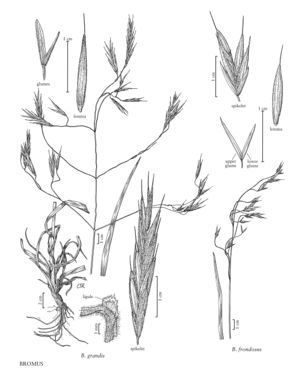Bromus grandis
Plants perennial; not rhizomatous. Culms 70-180 cm, erect; nodes 3-7, pubescent or puberulent; internodes pubescent, puberulent, or glabrous. Sheaths densely pubescent, hairs to 1 mm, collars with hairs to 2 mm, midrib of the culm leaves not abruptly narrowed just below the collar; auricles sometimes present; ligules 1-3 mm, densely pubescent to pilose, obtuse, lacerate; blades (13) 18-38 cm long, 3-12 mm wide, flat, sparsely to densely pubescent on both surfaces. Panicles 14-27 cm long, very open, nodding; branches flexuous, usually widely spreading, with spikelets near the tips. Spikelets 20-37 (45) mm, elliptic to lanceolate, terete to moderately laterally compressed, with 4-9 (10) florets. Glumes pubescent, with prominent veins, margins not bronze-tinged; lower glumes 4-8.5 mm, (1) 3-veined; upper glumes 7-10 mm, 3 (5) -veined, not mucronate; lemmas 9.5-14 mm, lanceolate, rounded over the midvein, backs pilose, pubescent, or glabrous, margins pilose, not bronze-tinged, apices subulate to acute, entire; awns 3-7 mm, straight, arising less than 1.5 mm below the lemma apices; anthers 3-6 mm. 2n = 14.
Discussion
Bromus grandis grows on dry, wooded or open slopes, at elevations of 350-2500 m. Its range extends from central California into Baja California, Mexico.
Selected References
None.
Lower Taxa
"decumbent" is not a number.
